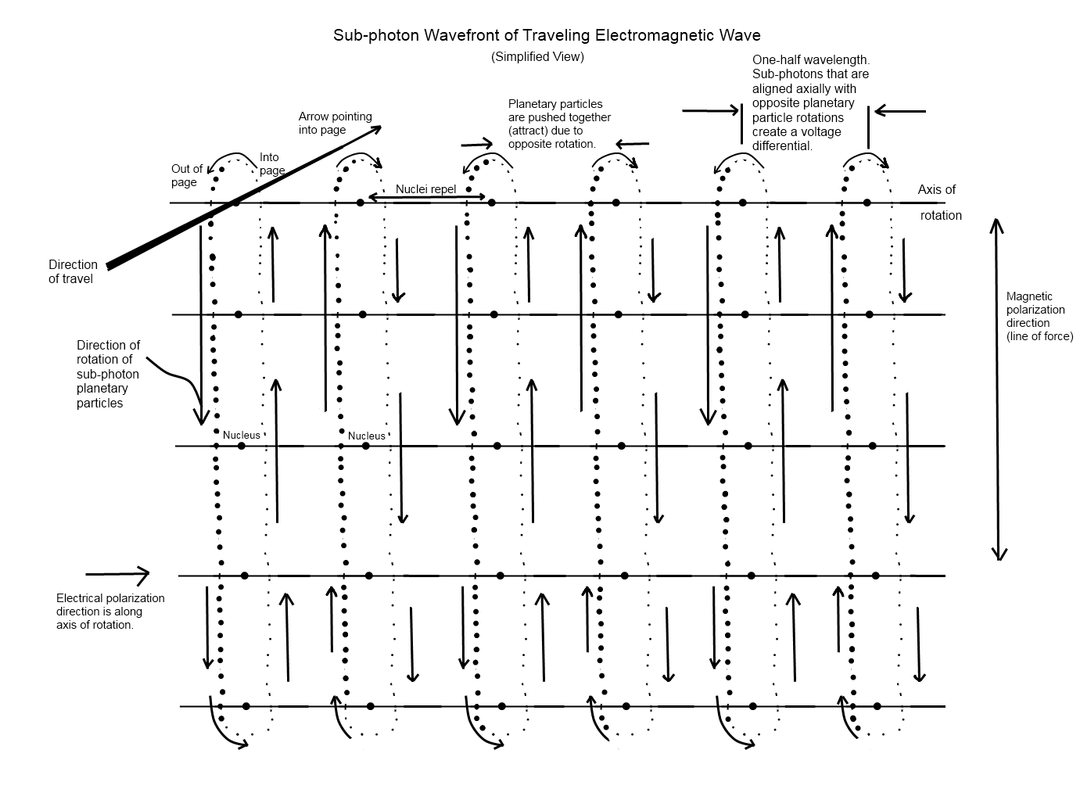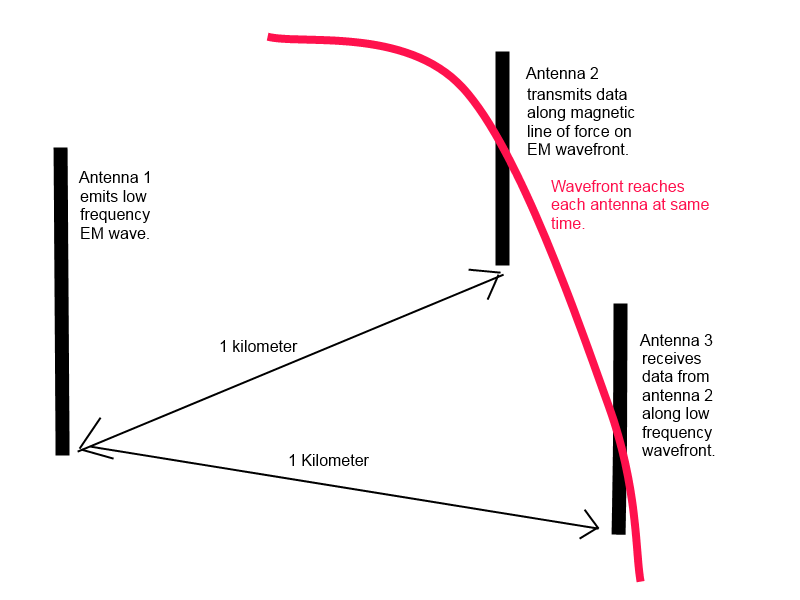Background information on sub-photon interactions:
As researchers are keenly aware, communication through space has been limited to the speed of light. The sub-photon concept does not dispute the limitations of communication presented by the speed of light using conventional means. According to previous papers on sub-photon interactions, the velocity of travel of electromagnetic waves is limited by the velocity of sub-photon nuclei through space. An unexplored facet of sub-photon dynamics is the interaction of sub-photon planetary particles with other planetary particles or sub-photon nuclei along a wavefront. Within a fractal universe concept, all particles are constructed of ever-increasing smaller particles. The smaller the size of the particle, the higher the velocity encountered. This concept of increasing velocities as particle sizes become smaller allows for proposals of faster communication speeds using sub-photon planetary particles or smaller particles.
The following illustration shows a simplified view of a sub-photon wavefront. As can be seen in the model, the sub-photon planetary particles along the magnetic axis tend to follow the same path, causing a shielding effect around sub-photon nuclei. This "shielding effect" creates a force that pushes sub-photon nuclei together if they are aligned along the magnetic axis. The paths of sub-photon planetary particles traveling along a common path can be found experimentally by determining the magnetic lines of force.
A sub-photon "wavefront" can be either stationary or traveling. A stationary wavefront can be created by direct current flowing through a wire/conductor. A stationary magnet also creates a stationary wavefront. A traveling wavefront can most easily be created by alternating current in a conductor/wire/antenna as described in a previous paper.

Harnessing the potential:
As stated earlier, sub-photon nuclei travel at the speed of light. What has not been clearly elucided before is the way sub-photon nuclei behave along a wavefront. Sub-photon nuclei of an electromagnetic wave are able to interact both along their electrical axis and the magnetic axis.
The sub-photon planetary particles rotate around or travel along nuclei in common paths if the rotation direction of their nuclei are in the same direction. Interactions along the electrical axis are limited to the speed of light since there is no continous extended path for the flow of sub-photon planetary particles in any particular direction.
Interactions along the magnetic axis can occur much faster and over greater distances than along the electrical axis since there is a continous path for sub-photon planetary particles to travel along the magnetic axis of a wavefront.
The above diagram of a wavefront is simplified because it does not show how "shielding" causes sub-photon nuclei to group together along a wavefront. Since sub-photon nuclei repel each other, the "pressure" or force that pushes them together creates stored energy in these compressed particles. The greater the concentration of similarly polarized sub-photon nuclei that are clustered along a wavefront, the greater the voltage differential that will be produced upon contact with a conductor/antenna. Higher frequeny waves tend to compress these sub-photon nuclei into smaller areas, making high frequency waves more energy dense. Even the following model is simplified since it does not display randomly polarized or alternatively polarized nuclei that may be travelong along a wavefront.

Harnessing the potential speed of sub-photon planetary particles along the magnetic axis requires a slightly more sophistocated approach to communication compared to simply using wires/conductors along the electrical axis.
Experiment Proposals to test or refine the sub-photon concepts:
There are 2 ways envisioned of conducting information at speeds greater than light:
The first method uses a low frequency electromagnetic wave transmitter antenna constructed vertically and at an exact distance (ex: 5 km) from a second antenna. A third antenna would be constructed the same exact distance from the first antenna. A radio transmission from the first "transmitter" antenna would reach antenna #2 and antenna #3 at the exact same time due to their distances. Antenna #2 and antenna #3 could be spaced a variable distance from each other, as long as they receive the wavefront from antenna #1 at the exact same time. The heights of antenna #2 and antenna #3 would have to be calibrated so that they receive the same polarity of the electromagnetic wave along comparable parts of the antenna at the same time. In this construction of antenna, we are trying to make the lower part of antenna #2 and antenna #3 to be constructed along the exact same magnetic lines of force, with sub-photon planetary particles traveling in the same direction at the same time and along the same line of sub-photon nuclei. Although the velocity of wave travel from antenna #1 and antenna #2 are limited to the speed of light, transmissions from antenna #2 and antenna #3 can potentially be much faster (based on the sub-photon model) using different methods. If we use antenna #2 as a secondary transmitter, we can alter the strength of the magnetic lines of force traveling from antenna #2 to antenna #3. These alterations of strength of magnetic lines will be received by antenna #3 as only faint fluctuations in the wavefront intensity but should be transmitted much faster than light speed.

The second method involves construction of a "magnetic" cable or conductor. Instead of conducting electricity along an electrical axis, this "conductor" would be tasked with the production of a continuous "magnetic line of force" along its entire length. The entire length of the "magnetic" cable would likely have to be constructed and polarized at the same time, to allow for a continuous magnetic line of force from one end to the other. On each end of the "magnetic" conductor, antennas would be placed and oriented at 90 degrees from the cable direction and along the electrical axis. These "antennas" would bisect the same magnetic line of force on each end of the cable. For this purpose, the antennas would be called antenna #1 and antenna #2. Changes in the current flowing through antenna #1 should transmit along the magnetic line of force and be received by antenna #2. These would essentially be magnetic transmissions along a stationary electromagnetic wavefront. As stated previously, if these magnetic lines of force were truly created by faster-moving sub-photon planetary particles instead of sub-photon nuclei, then the speed of transmission may exceed the speed of light.
